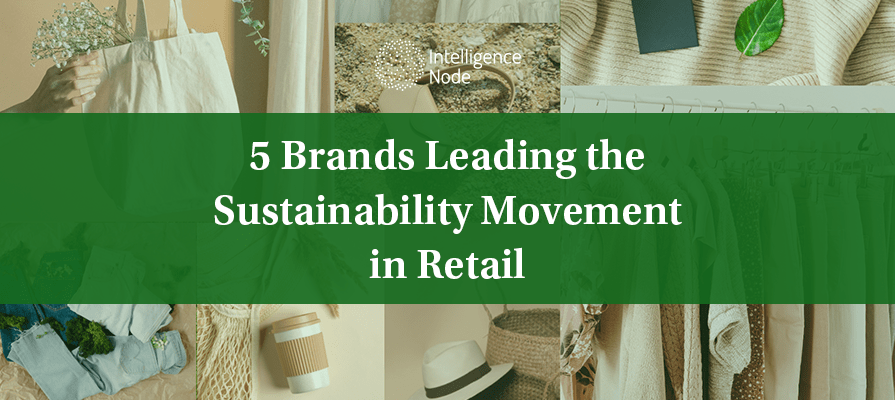A New Era of Sustainable Retail
The final sprint leading up to the year 2023 has made for some powerful headlines in the realm of sustainability. With calls of ‘greenwashing’ following even the 2022 United Nations Climate Change Conference (or the ‘COP27’ as it is more commonly known) and its controversial Coca-Cola sponsorship, retailers across the globe are calculating their next moves more cautiously than ever before.
Changing Retail Climate
According to a recent study, an average of 75% of shoppers, regardless of their generational group, are concerned about brands offering sustainable products and maintaining sustainable practices. Currently, there do exist varying claims of consumers’ willingness to pay more for greener alternatives, with some sources and surveys claiming that more expensive green products are lacking in sales. However, the ‘Global State of the Consumer’ tracker by Deloitte found that not only were shoppers routinely purchasing greener alternatives to their everyday products, but 32% said they paid significantly higher prices for them.
Furthermore, the environmentally motivated switch to local, small businesses, along with the PR fanfare and popularity following major brands’ green initiatives, even when accompanied by critique and backlash by some, prove that shifting behavior trends all point to a dire need for clear action.
To analyze the changes major businesses have made in order to adapt to this growing need, the research ahead focuses on five key consumer-facing brands -popular household names, pantry staples, and well-recognized labels- to see how various segments have responded to the same.
1. Mars Inc.
Over the last few years, the world’s favorite chocolatiers have been subject to deep scrutiny. As a generation of “woke” young consumers stepped into the forefront with research on the importance and impact of single-origin sourcing, ethical production, and animal-based products, the operations of global chocolate brands have changed with the market. Today, “single origin” is a term we see on many CPG products, production methods have been called into question for wastefulness or ethics, and the recipes of crowd favorites have been altered over time. Most noteworthy, many popular treats now boast ‘vegan’ versions of themselves in stores everywhere- albeit with slightly more challenging price tags.
The world’s biggest chocolate brand, Mars, has pioneered this new wave. The vegan chocolate market is already valued at $533 million and is expected to grow rapidly- for its more sustainable sourcing, smaller carbon footprint, and overall environmental impact. Thus, vegan versions of Bounty, Topic, and Galaxy chocolates will now be joined by Mars’ first sustainability-focused, animal-free chocolate bar for the USA: CO2COA. Created in collaboration with food tech company ‘Perfect Day’, this aptly named offering contains certified cocoa and a reduction in CO2 emissions due to plant-based ingredients. The bar is Mars’ stepping point towards the eventual goal of net zero greenhouse gas emissions across its value chain by 2050.
2. Walmart
Walmart, as one of the largest retailers in the world, houses a vast multitude of brands, ranging from fashion, kitchenware, electronics, fresh produce, CPG goods, and more. The business thus employs shipping facilities, stores and refrigerates goods, and manages in-store inventory, among scores of other operations. In this setup, carbon emissions and unsustainable practices can be seen in excessive packaging material, overstocked inventories consuming greater amounts of energy to keep fresh, wastage of fresh goods, and even in energy-inefficient lights and ventilation systems within the stores themselves. However, in the realm of operations where they maintain total control, Walmart has taken bounds towards sustainability: its in-house private label brands.
Walmart Inc. has revealed several green initiatives over recent years, starting with replacing the packaging of its in-house brands with plant-based fibers and recycled materials, aiming to achieve entirely reusable or industrially compostable packaging by 2025. Further, for fresh consumable products, Walmart has reworked its supplier partnerships to produce greater volumes of food in a more energy-efficient manner. It has also begun to invest in solar and hydro energy sources. The retailer has carefully measured the impact of its supply chain over the years, engaging with NGOs and relevant organizations to transform its operations effectively. Walmart’s goal is to hit zero emissions across global operations by 2040.
Generate the best possible pricing strategy for your sustainable offerings, Intelligence Node’s cutting-edge, highly accurate pricing tools are your best bet for rapid, actionable results. Book a demo today to learn more!
3. H&M
Of every sustainability-driven segment on the market, fashion’s foray into greener ventures has been the most cutthroat. Fast fashion giants such as Shein, BooHoo, and H&M have been hit with harsh criticism for overproduction, wastage, disposing of harmful synthetic dyes inappropriately, improper production standards, and more- including cries of greenwashing and misleading marketing. This has led to swarms of younger shoppers rallying against fast fashion as a whole. Gen Z has begun shifting their focus towards thrifting, recommerce, smaller local businesses, durable high-quality clothing, and green fashion startups, all in an effort to reduce the need to purchase fresh clothing, as garments pile up in landfills.
H&M has been following this shift closely, introducing several lines of recycled and recyclable clothing, as well as entire collections driven by a focus on sustainability. It is currently on its fifth major ‘green’ release. The brand has pulled its garment collection program to the forefront, where shoppers can drop old clothes in bins present in H&M stores, in return for discounts. These clothes are then meant to be repurposed and recycled into new clothing. H&M group remains actively committed to identifying and acting upon greener initiatives, investing in the ‘decarbonization of its value chain’ and planet-positive solutions for the fashion industry. However, as some collections see steep increases in price owing to increased durability and quality of material, there is yet to be a breakthrough that connects with H&M’s key market. Gen Z shoppers with budget restraints remain limited to the brand’s more densely populated unsustainable shelves, relying on H&M for affordable clothing, and unable to afford their swankier green collections.
4. Sephora
The last several years have seen an exponential rise in the popularity of beauty products, with the “beauty community” expanding to include celebrity-manufactured makeup collections, fragrances, and more. With the growing influence of social media stars and makeup artists turned YouTubers, new curated palettes and collaborative product lines are released almost every season, each with devoted fans ready to participate in every makeup trend on the market. This, in itself, is not only wasteful to consumers (inspiring #ProjectPan, where makeup fanatics were urged to at least use enough of their makeup to reach the bottom of the pack before throwing it out) but wasteful to produce, market, and ship.
Sephora, for one, has laid out some criteria for its own sustainability efforts- in its formulations, energy consumption, and packaging. The brand claims to have diverted 1.9 million pounds of waste from landfills and has been an EPA Green Power Partner for 7 years. 100% of Sephora’s outlets, distribution centers, and corporate setups are powered by renewable energy. The business’s production practices and supplier partnerships have shifted towards a stronger focus on ‘social and environmental excellence’. The company’s chemicals policy indicates its efforts towards identifying unsustainable formulae and ingredients as well as alternatives that can be used. Finally, Sephora has rolled out recycled shopping bags made out of reused fiber and sustainably sourced materials, and a new clean + planet positive label that meets the brand’s sustainable packaging criteria.
5. Apple
Even in the smartphone industry, efforts are ‘ramping up’ as brands search for ways to reduce their carbon footprint in their operations. In this case, carbon emissions and pollutants rise from production processes, improper handling of electronic waste, excessive plastic packaging, and energy consumption. With Apple’s hardware ecosystem in the billions, and every new product release sparking a wave of new purchases, not only are we facing a massive e-waste issue, but the cyclical process of packaging, transportation, sourcing out materials, and more with each drop.
Apple has long since boasted achieving carbon neutrality for several of its operations and expects to be fully carbon neutral across its entire manufacturing infrastructure by 2030. With every new iPhone, the exact figures of their carbon footprint are gradually declining. Most interestingly, the company has worked towards making each generation of iPhones more energy efficient than the last, with the 13th generation boasting the least amount of energy wastage in the device’s charging process. The production process of Apple products involves a great deal of recycled materials- such as ‘hydro-smelted and recycled’ aluminum, and for the very first time, all rare earth, tungsten, tin, and gold components being used are 100% recycled. Finally, Apple has swapped plastic-addled packaging with chargers and complementary wires, with 95% fiber-based packaging and smaller, compact boxes. Of all its efforts, the ability to reduce the massive e-waste epidemic by recycling its older generation apple products and using the components to produce new devices has been the most impactful.
Green Disruptors in the Retail Arena
Green startups across the map have begun to outshine retail giants in their sustainability efforts, with environmentally sound practices at the heart of their operations, identity, and products.
Depop.com – peer-to-peer fashion selling platform
Dropel – generating apparel from performance-enhanced natural fibers
LOLI- Zero waste organic cosmetics
Wellow – Eco-friendly cosmetics in plant-based packaging
WNWN Food Labs – Bean-free chocolate
Impact Snacks – plant-based snack bars
The Way Forward for Sustainable Retail
Between eliminating single-use plastics, energy efficient operations, localized and single-origin sourcing and transportation, greener policies, sustainable packaging, and even switching to plant-based formulations and vegan production, retailers have a lot of jumping-off points to begin their journey to sustainability. However, for effective and impactful switches to greener efforts, an understanding of key markets and buyer needs can help brands identify where to initiate change, as well as the bandwidth of their loyal buyers to tolerate change, be it in price tags, delivery practices, packaging, etc. Understanding these touchpoints and appealing to increasingly environmentally conscious shoppers without alienating aspects of your business that attracted shoppers, to begin with, is key to running a greener business without slashing margins.





